Breastfeeding and beginning regular feeding
To Assess and Celebrate
• How were the home visits to the families with babies from 6 to 8 months?
• Which facilities did you find?
• Which difficulties did you feel?
• Was there any explanation from the Leader´s Guide which was not accepted by the mothers? Which?
• What else would you like to learn or talk about the babies from 6 to 8 months in your community?
• Based on what was seen and felt, what would you like to share?
Do you remember any biblical quotation, prayer or message that could illuminate this moment?
To See
The baby from nine to eleven months
1. Do the mothers continue to breastfeed, even after the introduction of other types of food?
2. How do the families handle the baby´s need to move around in this phase?

Foto:
In this age, besides the breast milk, the baby needs to make 3 meals more a day. If the baby is not being breastfed, he/she needs five meals a day. The food should be rich in iron, A vitamin and calcium. The baby’s body absorbs more A vitamin when little vegetable oil or olive oil is added into his/her food.
The baby is already eating the yoke of the egg but the white of the egg should only be offered as of one year old because it can cause allergy in some children.
Fish meat is a very nutritious food. Fresh fish is the best option. The fish meat should be firm, elastic and the scales should be adherent, the skin and the gills bright, the fish should have bright eyes and should not smell ammoniac.
The baby likes to try eating alone. It is good to put some food in the dish and leave it there for the baby to try to use the spoon. At the same time, the adult serves her/him most of the food from another plate. It is good that the baby have his/her own plate and eat at the family meals time together with the others. Then it is possible to know how much the baby has eaten and the baby learns that the meals are a family gathering time and that he/she belongs to the family.
How the baby can learn and grow
The baby still depends a lot on the mother or on whoever takes care of him/her. He/she continues to enjoy staying always close to the parents. Since he/she cannot stay with them all the time, he/she likes to play with things that the parents use such as: combs, brushes, pans, hammers, radio.
When the baby plays with boxes, tins, brushes, spoons and toys he/she learns two important things:
The purpose of the objects: the glass to drink, the pan to cook, the comb to comb the hair, the ball to play. How the objects are like: Hard or soft; big or small; rough or smooth; light or heavy.
The baby also learns when the parents and the family members talk to him how the objects are like and what the objects serve for.


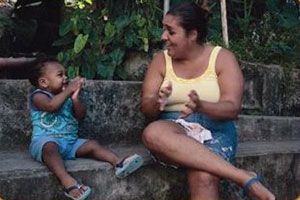
Foto:
Does the baby use gestures to communicate: pointing, clapping the hands and saying good-bye?
When the family gives attention and tries to understand what the baby wants to communicate, he/she learns to use gestures to say and ask for what he/she wants. When the baby points asking for something, it is good that the parents say the name of what was pointed at, so the baby can learn the name of the things he/she sees.
He/she understands, each day, more what the people say to him/her. Even though the parents can distract the baby for him//her not to do what is not allowed, he/she will try to do it again. When the parents say “no”, the baby stops what he/she is doing, even though later he/she does the same thing again. When the baby acts likes this, he/she shows that he/she is beginning to understand what is not allowed to do and to have the idea of what is to have limits set.
The parents have to decide how they will face the beginning of the baby’s disobedience. They both have to act firmly, without using violence and keeping with the prohibitions made.

Foto:
Do the family members say the objects, name and talk about the activities they do with the baby?
The baby tries to imitate the sounds he/she hears the family speaking and can already repeat some words on his/her own way. The baby says “da” when he/she wants something; and calls after the mother and the father saying “mummy – dad”. But he/she can also start to speak only later. The important thing is that the people speak to him about the daily activities, so that, at his/her own time, he/she starts to use the talk as his/her main instrument to say what he/she feels.
When a person asks the baby for someone that is out, for example: “where is daddy”, and he/she looks, looking for him, this shows that he/she does not need to see the father to know that he exists. This shows that he/she already keeps some things in his/her memory.
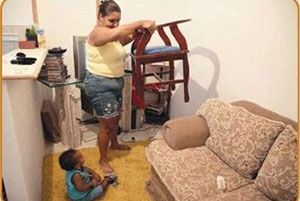
Foto:
Do the families make space for the baby to learn to move on his/her own?
In this phase the baby does not keep quiet, for he/she is learning to raise and to move on his/her own, mainly keep standing up. Therefore, he/she needs a safe space which allows him/her to try to move in several ways. If there is any person, a table or a chair, for example, to which he/she can hold/grab, he/she will try to stand up. But he/she may fall many times because of lack of balance. Most time he/she does not get hurt when falling.
For the baby to move with safety it is good that the parents arrange a place in the house. Better than forbidding the baby to move is to find a way or provide a place where he/she can do that. They should, for example, take out from his/her reach the objects he/she cannot take and block the access to the kitchen or to another dangerous place with a wood panel or a chair.

Foto:
Does the baby walk with support?
For the baby to learn and walk is also important to count on the help from people. He/she likes when his/her parents or siblings help him/her and encourage him/her to walk because he enjoys having their attention. Like everything he/she learns, first he/she walks with the help of others and after he/she walks alone.
The baby already shows his/her feelings. He gets jealous when the mother holds another child in her lap. He/she gets sad when people chide at him/her. He/she gets happy when the parents show they appreciate what he/she does. The baby likes a lot to play with his/her brothers and sisters but he/she does not like to lend or share the toys.
Taking some sun, playing outside the house and breathing pure air help the baby to eat and sleep better. He/she can also learn more, for he/she sees other children, people and different things. When the baby goes out with the parents on a bicycle, bus, horse track or car, the baby should be tied very safely to avoid any accidents.
“You have given me your protecting shield; your right hand has upheld me; you stooped to make me great.” Psa 18,36
Home accidents
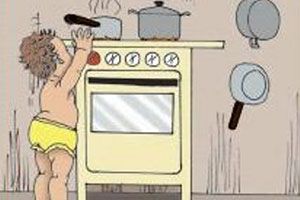
Foto:
The baby tries to move around in the house and the kitchen is the place that most calls him/her attention. It is there that the mother or who takes care of him/her spends most of the time, and where he/she finds interesting things to play with. Thus, it is in the kitchen that the accidents usually happen with the child.
The family has to watch for pan handles to be turned to the stove. It is necessary to watch for the hot oven so that the baby does not touch it and gets burnt.
If the baby gets burnt, the parents should make cold or icy bandages on the burnt spot to reduce the pain. They should not pass anything on it without medical prescription or perforate the bubbles to prevent infections.
It is necessary to remove from the baby’s reach things that he/she may catch and get cut with such as glasses, scissors and knives.
Dangerous are also those things which the baby can take or put to the mouth and get poisoned such as medications, kerosene, sanitary water, sodium hydroxide. Therefore, the cleaning products should not be kept in soft drink bottles. If the baby takes any medication or cleaning product, he should be immediately taken to the health service unit.
Analysis of the child’s situation according to the Indicators of Opportunities and Achievements
We shall see now how to interpret the responses to question 13, examining the answers to questions 14 and 15 of the Leader’s Notebook, which complete the registration of Indicators of Opportunities and Achievements. It is not necessary to answer the questions at the moment of the visit. Choose a quiet moment to do so.

Let us think about the meaning of answers to question 13 and 14.
When in a certain month none of the indicators to question 13 is reached, we say that this is an unfavourable situation for the child’s development. This can mean that the family and the community are not managing to provide opportunities for the child’s development and therefore, the child has not presented the achievements pointed out by the indicators. Like all situations, this can also be changed but it requires to be soon investigated by you, leader. The family might be going through a difficult period that has been disturbing the family harmony. Talk to the family and help them to find solutions.
If, for the following months, the indicators continue not to be reached this indicates that the family continues unable to overcome the hard situation which is going through, even with your support, leader.
We know that is not only up to the family to meet all the child´s needs. The parents need to find, where they live, support from the health service, education and also from the child´s social assistance, in cases of much poverty. They still need help from other family members, from their neighbours and friends to form a solidarity and love network for the child to be raised in a favourable environment for the children´s development.
It is important to think about the unfavourable situations for the development of the child, for example:
• When the family has no access to the health and education services or to adequate housing; or the parents do not find jobs, or what to do when problems such as discouragement, violence or alcoholism occur. The difficulties are so many that the family members end up giving little attention, tenderness or encouragement to the child in the way an amount he/she needs to be able to grow and develop;
• When the child gets sick and this disease repeats or takes a long time to be healed. The child gets weak, loses weight and also loses the wish to learn, play and the people in the family do not seek for other ways to encourage the child;
• When the child suffers from some kind of violence: abandonment, spanking, sexual abuse, this indicates that there is a problematic case in the family.
Therefore, the basic attitude that you, leader, need to have in view of the indicators should always be that of investigating. The indicators are the first clue for you to find, together with the family, the other leaders and with the coordinators what is taking place. The indicators should not be used to label the family as negligent, uninformed or one that has no interest in taking care of the children, or less to label the child as sick, tardy or deficient.
When all the indicators are reached, the leader should celebrate with the family and value the opportunities which are provided to the child. But the family has to continue to observe, even if the child keeps on at the same age rate, because the indicators show the life situation of the child, and this may change: the opportunity can be left without being provided and the child can no longer reach that achievement.
Therefore, the answer [Y] (Yes) is an indicator to be celebrated. The answer [N] (No) should always be investigated.

.
Hygiene

Foto:
The cares with the body hygiene and with the home hygiene are important to the whole family’s health but mainly to the baby’s, for they prevent many diseases. Since the baby likes catching everything, his/her hands should be washed every time before eating.
At bath time, the baby likes to pass the soap on the body. When the parents tell him/her the parts of the body while he/she does that: head, hands, feet, the baby soon learns their names.
The baby now can have eight teeth which need to be washed to avoid keeping food leftovers which may cause tooth decay. The tooth decay is a disease caused by bacteria which pass from one person the other. The baby can also catch these bacteria with spoons, cups used by other people or when the baby sucks a dirty or badly washed pacifier.
t is necessary to instruct the family not to blow or chew the food before giving to the baby. Tooth decay can also be transmitted this way.
Vaccines
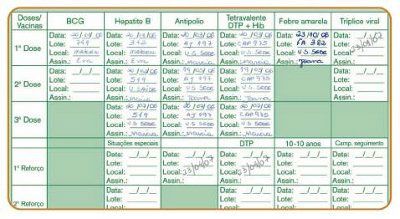
In Brazil, the yellow fever is usually caught when a non vaccinated person goes/lives to in wild transmission areas (tropical savannah ecoregion, forests).
In the ninth month, the baby has to take the sole vaccine against yellow fever if he/she lives or shall travel to:
• Endemic areas, or that is, locals where the disease exists (Brazilian States, AP, TO, MA, MT, MS, RO, AC, RR, AM, PA, GO, DF);
• Transition areas, that is, to the places where the disease might occur (some municipalities of the states PI, BA,MG,SP,PR,SC and RS);
• Potential risk areas (some municipalities of the states of BA, ES and MG).
If the baby and the persons of his/her family are to travel to any risk area, they need to take the vaccine against yellow fever at least ten days before the travel.
Worms
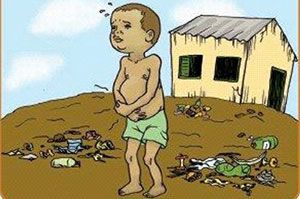
Foto:
Worms are intestine infections caused by various types of worms. The commonest way to catch worms is from drinking contaminated water or eating contaminated food.
When the child has worms, he/she can complain of pain, crumps, feeling sick in the tummy and have vomits, diarrhea, and loss of weight, anemia and fever. When worms are not treated it can cause complications, since the worms prevent the body from absorbing the food nutrients, leaving the child more vulnerable to infections and anemia because of the lack of iron.
In order to prevent the baby from getting worms it is necessary to take care of his/her personal hygiene, the home and food hygiene. It is also important that the community fights for adequate sanitation conditions and for quality health services.
When the baby has worm symptoms it is necessary that the family seeks for the health service for him/her take proper treatment.
Summary of each month follow ups in the 4th part of the Leader’s Notebook
In the fourth month of the Leader’s Notebook, you can fill in the summary of the follow ups you made. This part will help you to verify how your follow up of the pregnant women and the children is working throughout the year.
Fill in instructions:

• It is important to fill in the fourth part of the Leader’s Notebook before the Evaluation and Feedback Meeting. You will have more information about this meeting on pages 245 to 248 of this Guide;
• This meeting should be held after the month the data referred to ends;
• Fill in the top part of the form “Summary of every month's follow up” according to the instructions of your area coordinator.
• Each column of line A, numbered from 1 to 12 represents 1 month.
• Each month add the number of the families registered in the Notebook and note down the result on line B;
• When you register a new pregnant woman, the leader should count it as a followed up family, even though there was no other children registered in the Child’s Pastoral;
• Put a [ - ] (dash) when there is no answer to a question.
• In question 1 add all the children that are registered in this notebook and that have not left the Child’s Pastoral yet;
• In question 2 add the children younger than one year old that are registered in this notebook and that have not left the Child’s Pastoral Program yet;
• In question 3 add the [Y] (Yes) of question 6 of the first part of the Notebook and note it down;
• In question 4, note down how many children visited are younger than 1 year old and who have not left the Child’s Pastoral. Verify question 5 of the first part of the Leader’s Notebook;
• In question 5, sum the children that are completing 6 months this month, according to the age marked in question 5 of the first part of the Leader’s Notebook;
• In question 6, sum how many [Y] (Yes) were noted down in question 4 of the first part of the Leader’s Notebook;
• In questions 7 through 26, add the [Y] (Yes) to the respective question of the first part of the Leader’s Notebook and note it down;
• In question 27, write down the number of children who were born this month – verify question 1 of the first part of the Leader’s Notebook and write it down;
• In question 28, write down the number of children that were born with low weight this month – verify questions 1 and 2 of the first part of the Leader’s Notebook and write it down;
• In question 29 write down the number of children younger than one year old who died this month – verify question 28 of the first part of the Leader’s Notebook and write it down;
• In question 30, write down the number of children form 1 through 6 years old incomplete that died this month – verify question 28 of the first part of the Leader’s Notebook and write down.
FABS – Follow up Sheet
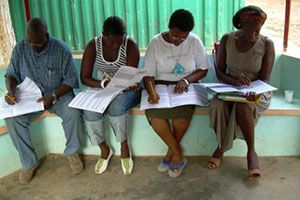
Foto:
The Monthly Follow-up and Assessment Sheet of the Health and Education Basic Actions in the Community – is the tool in which are registered the data of all the pregnant women and the children followed by the leaders of one community.
Once a month, at the Evaluation and Feedback Meeting you and the other leaders get together with your Community Coordinator to fill in the “FABS” sheet together.
In order to fill in the “FABS” sheet, copy the data of the fourth part of the Notebook of each one of the leaders. This sheet should be signed by the Community Coordinator and revised by the Area Coordinator.
Whithn the “FABS” sheet filled in, it is easier to SEE and EVALUATE how the situation of the children and the pregnant women is like. This makes it possible to plan the ACTIONS to try to change that situation. It is also possible to ASSESS and CELEBRATE each progress achieved.

Foto:
The “FABS” of each community should be sent to the National Coordination of the Child’s Pastoral. There, the FABS data enter into the Information System of the Child’s Pastoral. Thus it becomes easier to know:
• How the health of the followed pregnant women and the children is:
• How the children are growing, learning and developing;
• What is working well in the walk and what actions need to be strengthened;
• The results obtained.
Every three months, the National Coordination of the Child’s Pastoral sends the “Quarterly Report” to all the Local, Area, Sector and State coordinators with the results obtained through and registered in the “FABS”.
The “FABS” are also the data base of other reports sent to other institutions which support the Child’s Pastoral. Thus, many people, not only in but outside the Child’s Pastoral Program, acknowledge the works done by the leaders of each community.
When any mistake is detected/found in filling in any of the FABS, the sheet is returned to the community for it to be analysed, corrected and resent to the National Coordination as a corrected copy. Each FABS filled in by the leaders is of utmost importance for the Child’s Pastoral.
Each community data can be seen at internet: http://www.pastoraldacrianca.org.br
Home Visit
In these visits it is important:
To talk about feeding / breastfeeding
Talk about the baby’s development, particularly about his need to move around;
To remember the signs of danger.
Answer the questions of the Leader’s Notebook.
Suggestion for the task in this qualification stage:
Organize one life Celebration Day in the community.



